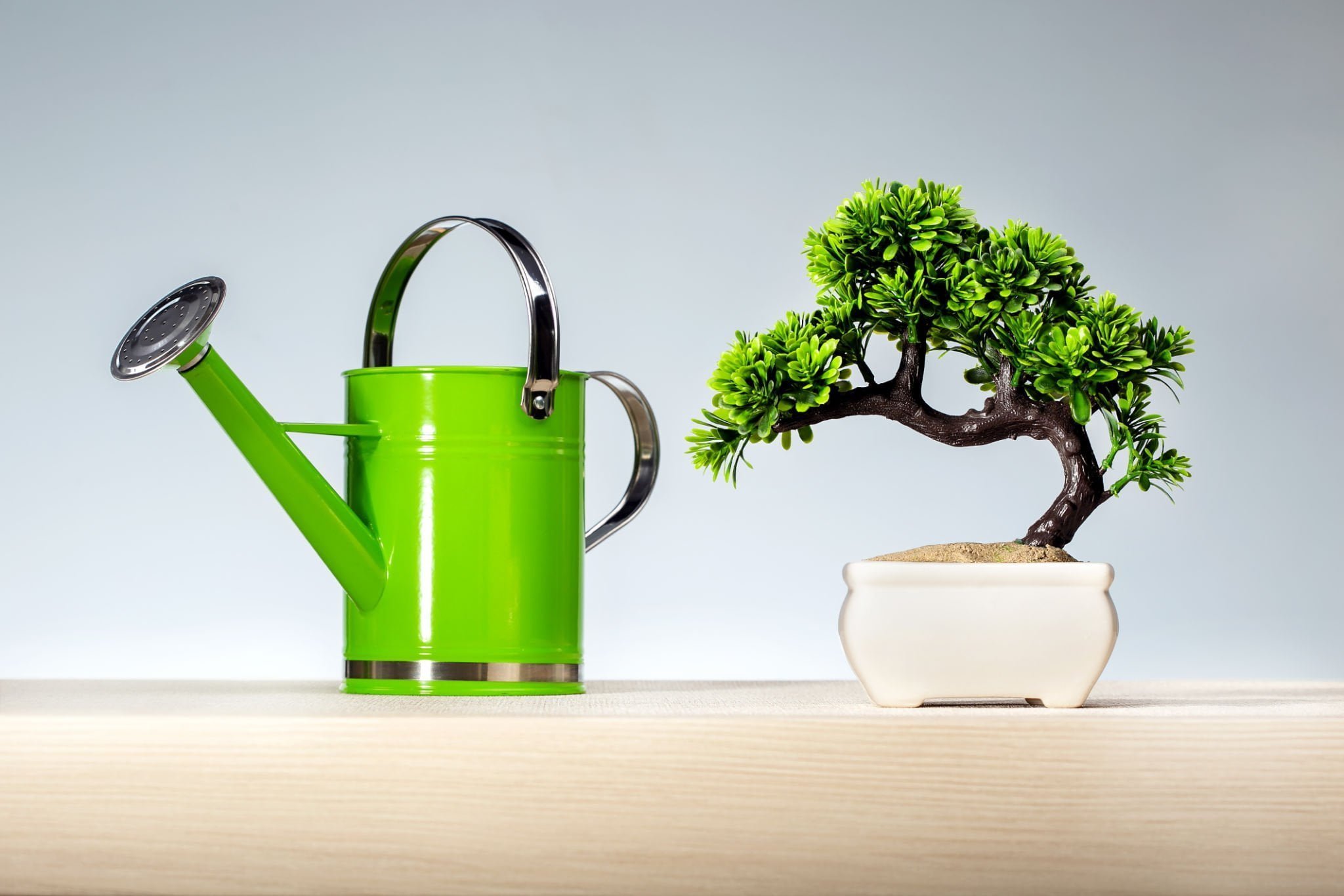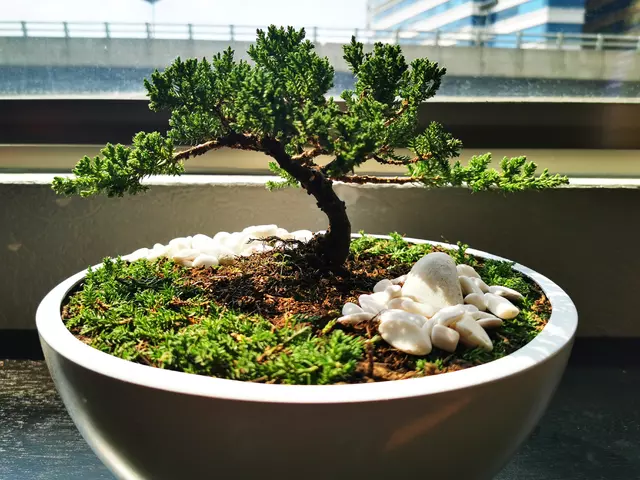Table of Contents
Looking for a low-maintenance, unique bonsai tree? Give a jade bonsai tree a go.
Jade bonsai plants are perfect for novice bonsai growers. They’re forgiving and low effort. Plus, you can keep them indoors or outdoors, depending on your local climate.
If you’re keen on growing a jade bonsai tree…
Keep reading to discover:
- The natural habitat and growth habit of jade plants.
- Two varieties of jade plants ideal for bonsai cultivation.
- A proper care and maintenance guide for your jade bonsai tree.
- And much more…
What is a Jade or Dwarf Jade Plant?
Botanical name: Crassula ovata / Portulacaria afra
Family: Crassulaceae (stonecrop/orpine) / Portulacariaceae (purslane)
Tree type: Broadleaf evergreen shrub or small tree
Foliage type: Oval, thick with cross-opposite leaf pattern
Growth habit: Upright
Native habitat: Dry regions of South Africa
Distinctive feature: Thick, fleshy succulent leaves
Meet the Jade Bonsai Tree
The Jade Bonsai Tree, also known as the dwarf jade plant, is a succulent native to the arid regions of South Africa, including Eswatini, Mozambique, KwaZulu-Natal, and the Eastern Cape. This evergreen shrub or small tree can reach up to 10 feet tall (3 meters).
Jade plants feature fleshy leaves about 1 to 2 inches wide. These thick, oval leaves store water, helping the plant thrive even during hot summer days. Notable characteristics include:
- Thick trunk
- Fine branch ramification
- Bark that ages from green to reddish brown
White, star-shaped flowers can bloom on soft shoots once a year from late winter to early spring, given the right conditions. These blooms appear in clusters at the branch tips on healthy, mature specimens.


Jade Bonsai Tree Varieties for Bonsai Cultivation
Two specific succulents often used for bonsai are Crassula ovata and Portulacaria afra.
Crassula ovata (Jade/Money Tree) and Portulacaria afra (Dwarf Jade/Elephant Bush) share similar features and growth habits. This means their care and maintenance needs are pretty much the same.
The main difference? Dwarf Jade has slightly smaller leaves, making it more suitable for bonsai cultivation.
If you’re looking to train a smaller bonsai (Shohin), go for the Dwarf Jade variety.
Note: You can reduce a regular Jade plant’s leaf size to half an inch with proper and regular pruning.
Quick Tips:
- Choose Dwarf Jade for smaller bonsai.
- Regular pruning helps manage leaf size.
Jade Tree cultivation is straightforward, making it a great choice for beginners.
Locations: South Africa, Eswatini, Mozambique, KwaZulu-Natal, Eastern Cape.
Plant Families: Crassulaceae, Portulacariaceae.
Plant Species: Crassula ovata, Portulacaria afra.
How to Care for a Jade Bonsai Tree
Jade Trees are a breeze to grow, making them ideal for beginner bonsai artists.
If you’re ready to cultivate one, here’s a care guide you can follow:
Quick General Care Guide for Jade Bonsai Trees:
- Positioning: Thrives both indoors and outdoors, depending on the local climate.
- Watering: Only water when needed—once the topsoil dries up.
- Feeding: Apply slow-release fertilizers during the growing season.
- Pruning: Prune shoots back to 2 to 3 leaves in the spring or summer.
- Wiring: Can be done year-round, but best after pruning for convenience.
- Repotting: Repot when necessary, usually every 2 years in the spring.
- Overwintering: Move to an unheated room once the temperature is around 10°C (50°F).
Jade bonsai trees, also known as Crassula ovata or Portulacaria afra, are low-maintenance and perfect for beginners. If you’re starting out with bonsai cultivation, this guide will help you keep your jade bonsai healthy and thriving.
Position your jade bonsai tree in a spot where it can get plenty of light. Indoors or outdoors, it depends on your local climate.
When it comes to watering, only do so when the topsoil dries out. Jade bonsai are succulents, so they don’t need frequent watering.
Feed your tree with slow-release fertilizers during the growing season to keep it nourished.
For pruning, trim the shoots back to 2 to 3 leaves in spring or summer to maintain its shape.
You can wire your tree any time of the year, but it’s easiest after pruning.
Repot your jade bonsai every 2 years in spring to give it fresh soil and room to grow.
In winter, move your tree to an unheated room when temperatures drop to around 10°C (50°F).
Where to Place a Jade Bonsai Tree
The Jade Bonsai Tree thrives in both full sun and partial shade, making it an ideal indoor tree for beginners.
Positioning Tips:
- In temperate regions, keep your dwarf jade plant indoors with a few hours of direct sunlight daily. A south-facing window works best.
- During summer, place your Crassula ovata outside to boost growth.
- In tropical and dry regions, grow it outdoors with ample sunlight for optimal health.
Quick Signs of Proper Sunlight:
- Red Tips or Edges on Leaves: Your succulent bonsai is getting enough sun.
- Losing Leaves: Indicates insufficient light absorption.
Watering Your Jade Bonsai Tree
Watering
Compared to other bonsai trees, Jade Bonsai Trees can handle drought better. Their thick, fleshy leaves store water, so they’re less likely to suffer from underwatering.
Important: Even though jade bonsai isn’t as sensitive to over-watering as other succulents, only water when necessary. Too much water can break the limbs.
Watering Based on the Season
To avoid underwatering or overwatering, tweak your watering routine according to your jade bonsai’s needs.
In Spring
- Check your bonsai daily.
- Only water when the soil is dry to avoid over-watering.
- When watering, drench the entire pot.
In Summer
- Mist the foliage daily with a spray bottle to keep it moist on hot days.
- If indoors, use a humidity tray filled with water.
In Autumn and Winter
- As temperatures drop, jade plants need less water.
- In cooler climates, you might only need to water every few weeks.
By adjusting your care based on the season, you’ll keep your Jade Bonsai Tree happy and healthy all year round.
Fertilizing Your Jade Bonsai Tree
Want your Jade Bonsai Tree to thrive? Fertilizing is key. Especially for young ones. Keep it growing from spring through autumn.
You have options:
- Slow-release pellets
- Liquid concentrates
Use whichever suits you. Each product is different. Some need weekly applications, others bi-weekly or monthly. Follow the package instructions for the best results.
Pruning Your Jade Bonsai Tree
When it comes to pruning your Jade Bonsai Tree, here are a few simple techniques:
- Pinch off overgrown leaves.
- Cut heavy, unnecessary branches just above the node.
- Once shoots have 4 to 5 leaves, prune them back to 2 or 3 leaves.
These steps help your tree grow smaller leaves and branches, forming fine branch ramifications.
Prune in spring for quicker healing. Avoid using cut paste – it can cause wood rot. Keep your Crassula ovata looking its best with these tips.
V. Wiring and Bending
Jade Bonsai Tree branches are heavy because they hold water, which makes them naturally bend.
To shape them, wire your Jade Bonsai Tree in spring right after pruning. This way, you can easily reach the inner branches.
- Wrap aluminum bonsai wire tightly around the branches at a 45 to 50-degree angle.
- Monitor your tree after a few weeks because the soft bark can get wire cuts.
Want to turn your naturally-grown jade plant into a traditional bonsai? Watch this tutorial video.
Repotting
To prevent root rot and damaged roots, repot your Jade Bonsai Tree every other year in early spring.
- Use fresh soil in your bonsai pot for good drainage and aeration.
- If you don’t want your bonsai to grow larger, keep it in a shallow, small pot to limit its growth.
After repotting, don’t water your Jade Bonsai Tree for a week. This allows the cut roots to heal and dry naturally.
Winter Care
In temperate regions, bring your Jade Bonsai Tree indoors during winter.
Jade Bonsai Trees can’t handle frost. Once temperatures drop below 50°F (10°C) outdoors, move your tree to:
- Cold frame
- Greenhouse
- Unheated room like a garage
If your Jade Bonsai Tree drops leaves, it’s too cold. Move it to a warmer spot.
Pests and Diseases of the Jade Bonsai Tree
Your Jade Bonsai Tree can attract mealy bugs, spider mites, and aphids if neglected.
Mealy Bugs:
- Wipe infected areas with a cotton swab dipped in rubbing alcohol.
Aphids:
- Apply aphid-specific insecticide to the affected areas.
- Introduce natural predators like ladybirds or rove beetles to your tree.
Spider Mites:
- Use horticultural oil or insecticidal soap.
- Spray lukewarm water forcefully on infested spots.
- Apply an insecticide containing permethrin or pyrethrin.
Eradicating Pests on Your Jade Bonsai Tree
Without proper care, pests can lead to fungal growth. Deal with infestations promptly to protect your bonsai.
Jade Bonsai Care Tips:
- Keep your Jade Bonsai Tree healthy with regular maintenance.
- This low-maintenance bonsai adds texture and a unique look to your collection.
- With proper care, your Jade Bonsai Tree can thrive for decades, allowing it to be passed down through generations.
Keep it fresh, and stay on top of those pests to enjoy your beautiful Jade Bonsai Tree for years to come.
▶Click Here to download this article as PDF










